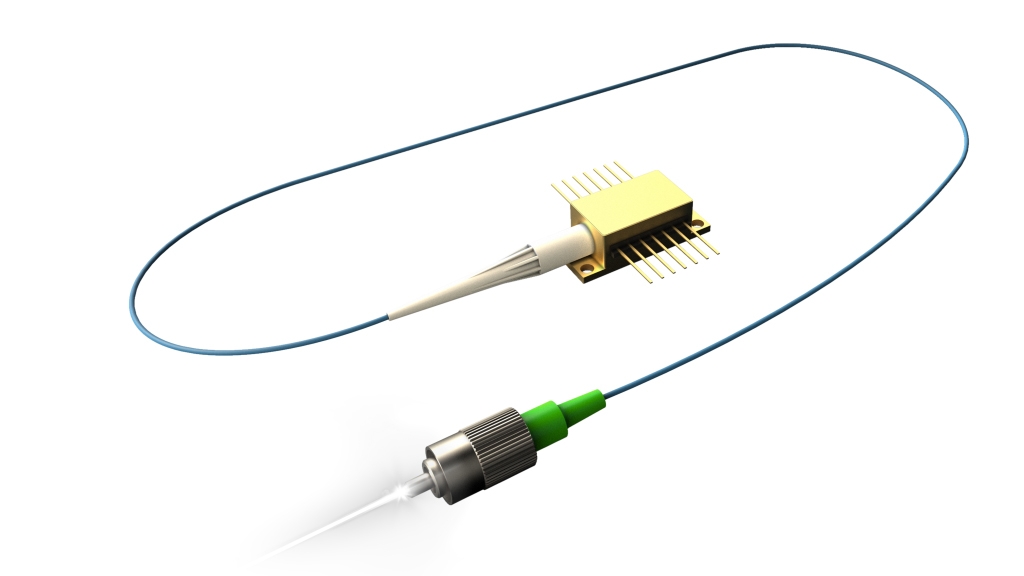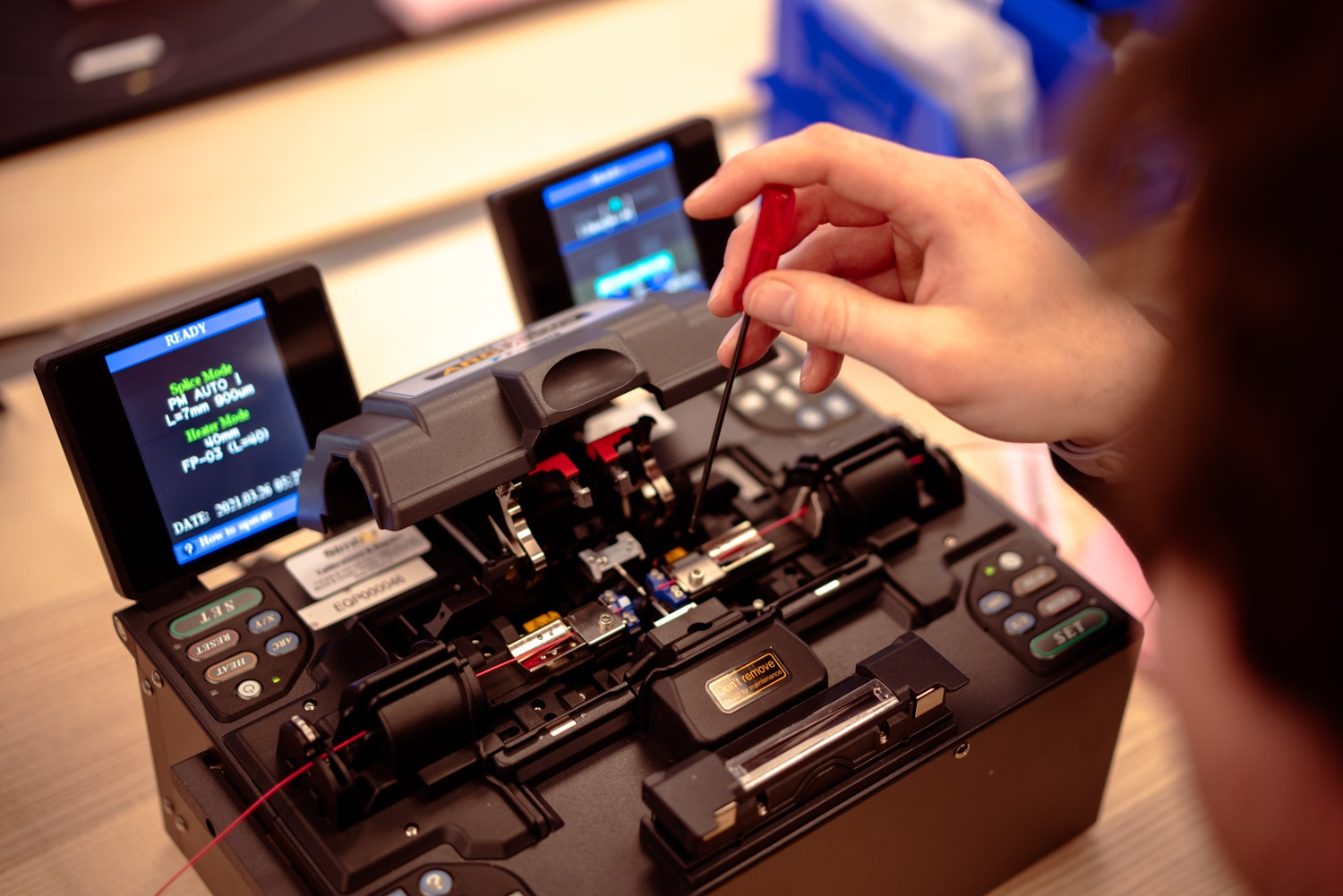A superluminescent diode (SLD of SLED) is a special type of light-emitting device that produces bright and broad-spectrum light. In basic terms, it’s like a combination of a laser and a regular light bulb – or light-emitting diode (LED). SLDs are commonly used in things like medical imaging machines and fiber optic communications.
When an electrical forward voltage passes through the SLD and its anti-reflection coated (ARC) facets, light is created. However, unlike a laser that produces a very focused and narrow beam, an SLD emits light that spreads out in many different colors and directions. This broad spectrum of light is useful because it can cover a wide range of wavelengths.
At its core, an SLD consists of a semiconductor gain medium, which is typically made of multiple quantum wells or quantum dots. These active regions are sandwiched between layers of semiconductor materials, forming a heterostructure. The gain medium is electrically pumped, and when current passes through it, it generates spontaneous emission of light.
History
In the mid-1960s, researchers began exploring the concept of amplifying spontaneous emission in semiconductor devices. Initial work focused on developing broadband light sources for optical communication systems and spectroscopy applications.
The superluminescent diode (SLD) was initially documented by Kurbatov et al. (1971) and later by Lee, Burrus, and Miller (1973). In 1986, Dr. Gerard A. Alphonse at RCA Laboratories (now SRI International) introduced an innovative design that facilitated the development of high-power SLDs. These light sources emerged as vital components in the subsequent generations of fiber optic gyroscopes, low coherence tomography for medical imaging, and external cavity tunable lasers used in fiber-optic communications. In 1989, the technology was transferred to GE-RCA in Canada, subsequently becoming a division of EG&G.
It is worth noting that superluminescent diodes are sometimes referred to as superluminescence diodes, superluminescent LEDs, or superluminescent light emitting diodes.
Characteristics
The distinguishing feature of an SLD is its optical cavity. Unlike a laser which has reflective mirrors to create a feedback loop and generate coherent light, an SLD has anti-reflection coatings on both ends of the cavity. This eliminates the feedback necessary for laser oscillation, resulting in the emission of incoherent light. However, the SLD is designed to have a long enough cavity length to induce a high degree of stimulated emission, leading to amplified spontaneous emission (ASE). This combination of incoherent and amplified light gives the SLD its unique superluminescent properties.
The output spectrum of an SLD is broad, typically ranging from tens to hundreds of nanometers, depending on the design and materials used. The broad spectrum is a result of the simultaneous emission from multiple optical modes within the cavity. The output is characterized by a relatively high spectral density and a smooth, Gaussian-like shape. The width of the spectrum is an important parameter and can be controlled by adjusting the cavity length, gain medium properties, and other design parameters.
Practical Applications
The high brightness and broad spectrum of SLDs make them valuable in many applications, such as:
- Telecom test equipment: Test operationality of high-speed coherent communications for Cloud infrastructure as well as data and telecom networks.
- Optical component testing: Test conditions such as external transmittance percentage and reflectance percentage. This is useful for optical fibers, filters, lenses, Fiber Bragg gratings, optical attenuators, photonic switches, broadband couplers, multiplexers, and isolators.
- Fiber Bragg Grating Sensor (FBG): One of the most popular choices for optical fiber sensors for strain or temperature, FBG sensors must be illuminated by a light source with a broad spectrum, like an SLD.
- Optical sensing: SLDs combine the spatial coherence of a laser diode and the temporal coherence of an LED, enabling usability within a wide range of optical sensing applications.
- Polarization testing: SLDs can evaluate the degree and effects of polarization on fibers, broadband components, and passive optical components.
- White light interferometry: Measures the shape of an object using light and without making physical contact with it.
- Medical optical coherence tomography (OCT): SLDs serve as the light source for imaging biological tissues at high resolution. The wide spectrum allows for better depth resolution and imaging performance.
- Industrial optical coherence tomography (OCT): SLDs serve as the light source for imaging material objects at high resolution. The wide spectrum allows for better depth resolution and imaging performance.
- Spectroscopy: SLD’s high brightness and broad spectrum are good for studying various materials and chemical compounds.
- Biomedical imaging systems: Also referred to as biophotonics, biomedical imaging systems allow exceptional imaging specifications of molecules and tissues, and procedures involving tissue fusion through light-activated chemicals.
- Metrology: Minimize the threat of optical interference during metrology (the scientific study of measurement) through low coherence length and ultrawide broadband spectrum.
- Fiber optic gyroscopes (FOG): Photonic sensors provide consistent, accurate navigation and monitoring capabilities for a range of manned and unmanned aircraft.
- Holography: Holographic images require a coherent light source, because the light beams must remain stable to capture the image.
Superluminescent diodes combine the characteristics of lasers and light-emitting diodes to produce a broad spectrum of high-brightness light. Their unique properties make them valuable in various fields, and the versatility and performance of SLDs continue to drive advancements, all of which contribute to the development of innovative technologies and applications.
Want to learn more about the practical applications of SLD’s? Contact DAYY Photonics anytime to talk about the specialized needs in your industry.


